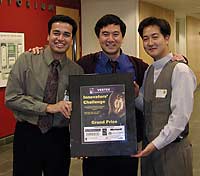|
Engineering trio
wins $10,000 prize for new type of semiconductor memory
16
April 2002
By Diane
Ainsworth, Public Affairs
Three Ph.D.
engineering students captured top prize in Berkeley’s first Innovators’
Challenge competition. The trio developed a new type of semiconductor
memory that could improve hand-held devices and miniature electronics.
Charles
Kuo and Daewon Ha, in the Department of Electrical Engineering and Computer
Sciences, and Pushkar Ranade, in the Department of Materials Science
and Engineering, were awarded the grand prize of $10,000.
Kuo, Ha,
and Ranade chose to develop a "capacitorless double-gate cell for
sub-100 nm DRAM technologies," noting that "there are no known
solutions that can be readily applied to scale DRAM (dynamic random access
memory) today," said Ranade.
| |

Left
to right: Berkeley graduate students Pushkar Ranade, Charles Kuo, and
Daewon Ha took first prize in the VERTEX Innovators' Challenge on April
13.
|
"While
a lot of work has focused on reducing the size of logic transistors,
much work and innovation are also needed in scaling memories," he
noted.
Sponsored
by VERTEX, an entrepreneurship club formed by Berkeley engineering students,
the competition culminated with the Saturday, April 13 judging. The event
at Berkeley's Soda Hall brought together 20 technology leaders from industry,
venture capital firms and academia, who evaluated 18 projects across
all disciplines in the College of Engineering. Judges included the founder
of Hotmail, the director of Advanced Systems at Microsoft Corp, a senior
vice president at Applied Materials and a partner at Sevin Rosen Funds.
Top sponsors included the founders of Berkeley startup Timbre Technologies,
Sevin Rosen Funds, Microsoft, Cadence Design Systems and Applied Materials.
Contest
judges praised the top team for developing a technology that could potentially
revolutionize industries and markets.
Ranade,
Kuo and Ha began to design their semiconductor cell a year ago as part
of a collaborative project in the College of Engineering’s Device
Research Group. "Electrical engineering and computer sciences professors
Chenming Hu and Tsu-Jae King were instrumental in supporting and advising
us along the way," the students said. "Devices for experimental
measurements were graciously provided by visiting professor Mansun Chan,
as well."
On Saturday,
anxiety was high as the teams waited for the judges to announce who had
won the competition. "When they didn’t announce our names for
honorable mentions and second/third places, we were nervous," Ranade
said. "We thought we did well, but were uncertain if we would capture
the top prize because of the stiff competition. But we were delighted
when our names were announced."
They celebrated
with friends at Sushi-Rika, "a great sushi restaurant in the city,"
Ranade reported.
The second-place
prize of $5,000 went to a group of electrical engineering and computer
sciences graduate students for their project, "Digital Lithography for
Next Generation IC Manufacturing." Third prize of $5,000 went to students
from nuclear engineering and physics for their "Maskless Micro-ion-beam
Reduction Lithography." Both of these technologies applied Moore’s
Law – creating circuits of increasingly smaller size and higher
performance – in different and creative ways.
However,
judges said they were impressed with the whole array of projects vying
for entrepreneurial recognition.
"I saw
several projects…that clearly could change the course of information
technology development," said judge David Lane, a general partner of
Diamondhead Ventures in Menlo Park. "The depth and breadth of the
revolutionary technology developments demonstrated was very impressive."
Several
of the projects held the potential of becoming "the basic building
blocks" of innovative new companies, Lane said. "Over the years
I have seen many projects at the best engineering schools in the U.S.,
and VERTEX’s winning projects definitely rank among the most promising."
|